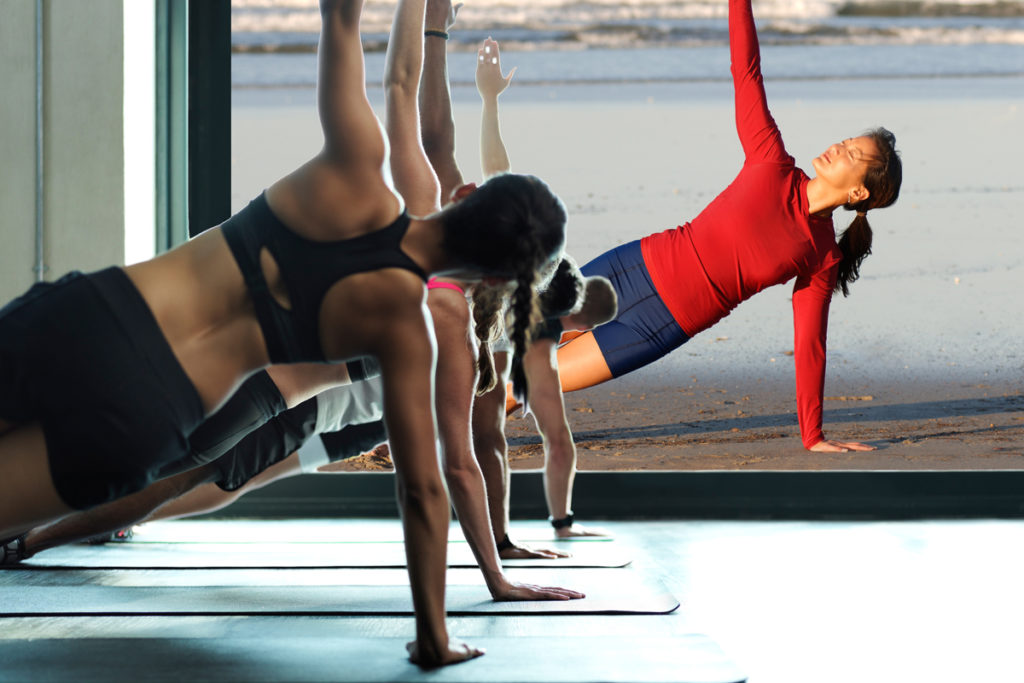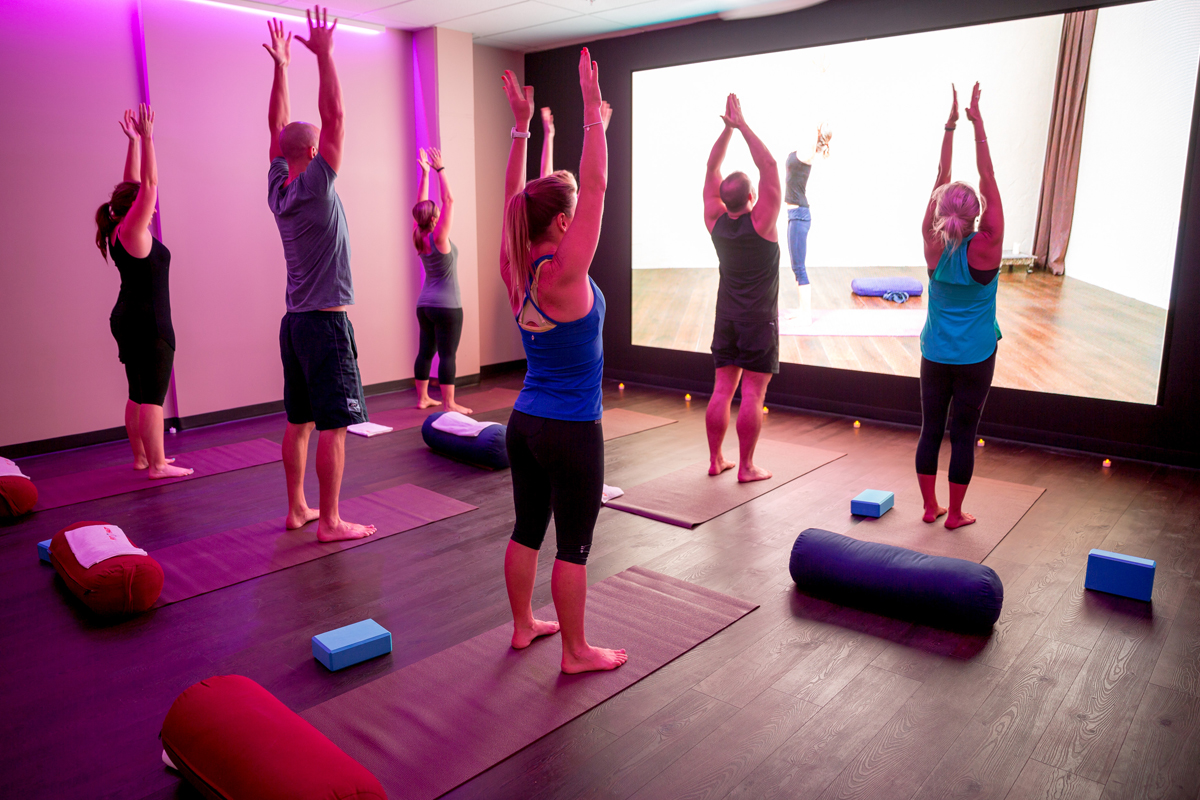Virtual Group Fitness Classes
Virtual classes have popped up in fitness facilities, but are they good for the industry?

Updated 5/5/21
Exercising in front of a television, computer screen or mobile device is nothing new. Since the advent of VHS tapes, group fitness programs have offered users an opportunity to get their sweat on whenever they choose in the comfort of their home. Over the past several years, however, fitness facilities have leveraged new technology to offer virtual classes on-site in hopes of luring exercisers out of their living rooms and into the group exercise room.
Here, several industry experts discuss the pros and cons of virtual group fitness classes.
Virtual Fitness 411
The typical virtual group fitness class is held in a group fitness room or indoor cycling room. Users select from a variety of class formats via kiosk or similar interface, press “Play” and then exercise along with an instructor who is projected onto a screen or monitor. Classes are prerecorded and are usually available on demand.
Why Virtual Group Fitness

Canada-based large-gym fitness chain GoodLife Fitness decided to roll out virtual classes 4 years ago for two primary reasons, says Maureen Hagan, the company’s vice president of innovation and fitness development.
First, virtual classes are accessible at any time, which means that members can take a class by themselves or with friends or family when live classes aren’t available.
“Not everyone is able to make it to scheduled instructor times and classes,” says Hagan. “More importantly,” she adds, “we wanted to bring group exercise to people who might feel intimidated by the live group experience. This is a way for those individuals who feel uncoordinated or uncomfortable to still engage in a class format. The hope is that at some point after using virtual they will feel inspired to transition to the live classes. It’s a good way to onboard new members.”
Rachel Southard, operations director for Anytime Fitness, headquartered in Woodbury, Minnesota, says that virtual makes a great feeder system for live classes and personal training sessions. Trainers and instructors can observe what’s happening in virtual classes, and they will often approach regular users to talk to them about their experience and discuss other options.
Holly Hust, owner and general director of Tahoe Mountain Fitness, a boutique studio in Truckee, California, has found virtual to be a welcome addition to the group fitness schedule. “Our students are happier, as they have more choices on the timetable,” she says. She adds that while live instruction is ideal, she takes comfort in knowing that the virtual classes she uses are well vetted and feature high-level instructors.
“When the art of motivation meets the science of proven results, we know that our students are getting a great fitness experience,” she says. “Another bonus is that if one of our instructors has an emergency or is sick and we have no one to sub, instead of cancelling class we can offer virtual.”
Alongside using popular group exercise classes from Les Mills and Wexer, GoodLife produces its own on-demand programs. Hagan says the company will often test new formats in the virtual studios to gauge interest; it’s a low-risk way to determine a class’s viability before putting it on the live schedule.
Finally, both Southard and Hagan have learned that virtual is a great selling point for prospects. Says Southard, “What we hear from our franchisees is that it has been an interesting tool for them to use on a tour. The prospects get really excited about it. It’s a nice amenity to entice new memberships.”
See also: The Mobile Health Map: Exploring Telehealth
Drawbacks to Virtual Group Fitness Classes?

QUALITY CONTROL
Naturally, like any emerging trend, virtual is not immune to critique. To put it bluntly, David Dellanave, owner of The Movement Minneapolis in Minneapolis, says, “Watching a video, live or not, of an exercise instructor is like watching a medical presentation by a doctor instead of being seen in an appointment.”
Virtual classes are no match for the live experience, he adds.
“Instructors aren’t just there to tell you what to do and then cheer for you,” Dellanave says. “They should be there to use their unique expertise and experience to make that workout as productive as it can possibly be. All of these gimmicks and attempts to scale that experience sidestep the entire point of having a skilled instructor. At that point you might as well hire a hype man or an emcee, because that’s all they’re doing.”
Everyone interviewed for this article more or less agrees with Dellanave that exercising with an instructor in person offers significantly greater value than using a virtual one. But on-demand programs still have a place in the fitness facility setting, they say.
“It’s in no way meant to replace the live group experience,” Hagan says. “We believe that nothing is better than the live connection a person has with a certified, credibly trained instructor.”
Adrian Heffernan, director of customer experience for Les Mills US, notes that virtual classes complement live ones. “There’s no substitute for a live class led by a rock star instructor,” he says. “Virtual works best alongside these classes to provide more workout opportunities at off-peak and shoulder times in clubs.”
In other words, in the same way that a foam roller can’t replace a manual therapist, virtual instructors aren’t a substitute for live ones.
See also: Is Tech Killing Personal Training?
DIMINISHED PARTICIPATION AND JOB LOSS
But even though the goal of virtual isn’t to squeeze out live classes, there is still concern that it might result in decreased live-class attendance, leaving instructors vulnerable to cancellations and job loss.
“Our research shows that virtual classes grow live-class attendance; participation in live programming increases by 12% at clubs that offer virtual programming,” says Heffernan. “It seems counterintuitive, but it’s true. This is because virtual programming supports members, ensuring they don’t miss a session, boosting results and engagement. And it lets lapsed or new users try group fitness in a low-risk setting.”
Hagan agrees. While she doesn’t currently have data to support the impact of virtual classes on their live counterparts, she’s heard from GoodLife instructors that they’ve seen an uptick in live-class participation. Also, she noticed that when the program first launched, instructors were resistant because they feared that they would become obsolete. Now, those same instructors champion virtual programming because it has helped them grow their classes, and it gives them more options if they need a last-minute substitute.
INJURY RISK in GROUP FITNESS
A major concern about virtual classes is that users are typically unsupervised, and the lack of coaching about form or other exercise specifics could lead to injury. While understandable, this concern is unfounded according to Hust, Hagan and Southard, who state that they have not received a single report of injury resulting from virtual classes. They say this is largely due to the high-quality nature of the on-demand classes available.
Southard says that the risks present in virtual group fitness programs aren’t very different from those of live ones. “I don’t see that it’s any different than taking a class with 50 other people,” she says. “There’s no way a single instructor can make sure that everyone is doing everything correctly. As long as the virtual classes feature high-quality instruction, the risk will be kept to a minimum.”
Hagan says she’s heard only good things about virtual from members. “We have not had a single incident that I’m aware of,” she says. “What I have seen and heard through testimonials is how much fun they have. Couples have date night. Girls do the dance classes with friends, and they’re singing and dancing. Personal trainers use it with clients.”
See also: Which Is Better: A Live Class or a Virtual One?
To Virtual or Not to Virtual

Virtual group fitness has its pros and cons, but as Hagan says, fitness facilities’ biggest responsibility is to provide consumers with what they want. “It’s easy to eschew the trend if you don’t believe in it,” says Hagan, “but the fact is that lots of people want it. If our goal is to get more people moving and joining us, then we have to provide as many options as possible for people to do that.”
Ryan Halvorson
Ryan Halvorson is an award-winning writer and editor, and IDEA's director of event programming.







